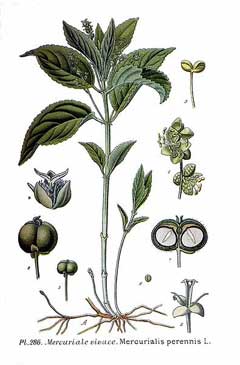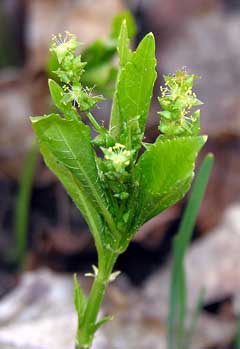 |
|
http://commons.wikimedia.org/wiki/File:286_Mercurialis_perennis_L.jpg |
 |
|
Translate this page:
Summary
Physical Characteristics

 Mercurialis perennis is a PERENNIAL growing to 0.3 m (1ft) by 1 m (3ft 3in) at a fast rate.
Mercurialis perennis is a PERENNIAL growing to 0.3 m (1ft) by 1 m (3ft 3in) at a fast rate.
See above for USDA hardiness. It is hardy to UK zone 4 and is not frost tender. It is in flower from February to April, and the seeds ripen from May to June. The species is dioecious (individual flowers are either male or female, but only one sex is to be found on any one plant so both male and female plants must be grown if seed is required). and is pollinated by Wind, flies. The plant is not self-fertile.
Suitable for: light (sandy), medium (loamy) and heavy (clay) soils. Suitable pH: mildly acid, neutral and basic (mildly alkaline) soils. It can grow in full shade (deep woodland) or semi-shade (light woodland). It prefers moist soil.
UK Hardiness Map
US Hardiness Map
Synonyms
Plant Habitats
Woodland Garden not Deep Shade;
Edible Uses
Edible Parts: Oil
Edible Uses: Oil
None known
References More on Edible Uses
Medicinal Uses
Plants For A Future can not take any responsibility for any adverse effects from the use of plants. Always seek advice from a professional before using a plant medicinally.
Emetic Homeopathy Ophthalmic Purgative Warts Women's complaints
Dog's mercury is poisonous in the fresh state, though thorough drying or heating is said to destroy the poisonous principle[4]. The fresh juice of the whole plant is emetic, ophthalmic and purgative. It is used externally to treat women's complaints, ear and eye problems, warts and sores[4, 9, 21]. A lotion made from the plant is used for antiseptic external dressings[4]. A homeopathic remedy is made from the plant[9]. It is used in the treatment of rheumatism, dropsy, diarrhoea and disorders of the gall bladder and liver[9].
References More on Medicinal Uses
The Bookshop: Edible Plant Books
Our Latest books on Perennial Plants For Food Forests and Permaculture Gardens in paperback or digital formats.

Edible Tropical Plants
Food Forest Plants for Hotter Conditions: 250+ Plants For Tropical Food Forests & Permaculture Gardens.
More

Edible Temperate Plants
Plants for Your Food Forest: 500 Plants for Temperate Food Forests & Permaculture Gardens.
More

More Books
PFAF have eight books available in paperback and digital formats. Browse the shop for more information.
Shop Now
Other Uses
Dye Oil
A fine blue dye is obtained from the leaves[1, 4, 115], it is turned red by acids and destroyed by alkalis but is otherwise permanent[115]. It resembles indigo[115]. A yellow dye is obtained from the leaves[61]. The seed is a potential source of a very good drying oil[61].
Special Uses
Scented Plants
References More on Other Uses
Cultivation details
Prefers a humus rich soil[13, 17]. Dog's mercury is a very invasive and common hedgerow plant, it should not be necessary to cultivate it. Male and female plants usually grow in separate clumps, the females being less common[4]. The leaves contain trimethylamine and, in the early stages of putrefaction or when bruised, they give off the smell of rotting fish[245]. Dioecious. Male and female plants must be grown if seed is required.
References Carbon Farming Information and Carbon Sequestration Information
Temperature Converter
Type a value in the Celsius field to convert the value to Fahrenheit:
Fahrenheit:
The PFAF Bookshop
Plants For A Future have a number of books available in paperback and digital form. Book titles include Edible Plants, Edible Perennials, Edible Trees,Edible Shrubs, Woodland Gardening, and Temperate Food Forest Plants. Our new book is Food Forest Plants For Hotter Conditions (Tropical and Sub-Tropical).
Shop Now
Plant Propagation
Seed - the plant shouldn't need any help in spreading itself, but if you are desperate to be completely overrun by it then you could spread the seed around when it is ripe in late spring and early summer. Division - once again, there really is no need to help the plant but you can divide the roots at any time of the year.
Other Names
If available other names are mentioned here
Native Range
TEMPERATE ASIA: Iran, Turkey, Russian Federation-Ciscaucasia (Ciscaucasia), Azerbaijan, Georgia EUROPE: Denmark, Finland, United Kingdom, Norway, Czechoslovakia, Austria, Belgium, Switzerland, Hungary, Netherlands, Poland, Russian Federation (European part), Belarus, Ukraine (incl. Krym), Former Yugoslavia, Albania, Bulgaria, Greece, Italy, Romania, Spain, France, Portugal AFRICA: Algeria
Weed Potential
Right plant wrong place. We are currently updating this section.
Please note that a plant may be invasive in one area but may not in your area so it's worth checking.
Conservation Status
IUCN Red List of Threatened Plants Status :

Growth: S = slow M = medium F = fast. Soil: L = light (sandy) M = medium H = heavy (clay). pH: A = acid N = neutral B = basic (alkaline). Shade: F = full shade S = semi-shade N = no shade. Moisture: D = dry M = Moist We = wet Wa = water.
Now available:
Food Forest Plants for Mediterranean Conditions
350+ Perennial Plants For Mediterranean and Drier Food Forests and Permaculture Gardens.
[Paperback and eBook]
This is the third in Plants For A Future's series of plant guides for food forests tailored to
specific climate zones. Following volumes on temperate and tropical ecosystems, this book focuses
on species suited to Mediterranean conditions—regions with hot, dry summers and cool, wet winters,
often facing the added challenge of climate change.
Read More
Expert comment
Author
L.
Botanical References
17
Links / References
For a list of references used on this page please go here
Readers comment